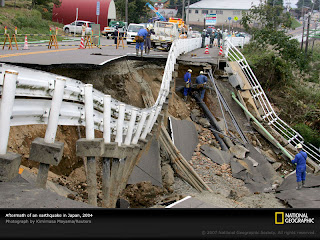Sunday, January 22, 2012
Natural Disasters
In this week's discussion post, we debated over which natural disaster is most devastating. Although there was not a unanimous consensus, what we understood afterward was that all natural disasters have the potential to cause devastation, locally and globally. One of our responsibilities as science educators is to not only teach our students to be scientifically literate citizens, but also to be advocates for social change and compassion. There are many opportunities to teach our students how to get involved in humanitarian efforts that stem from disasters arising all over the globe. This post is set up to give ideas on how to involve our students in the education of natural disasters and to involve them in the search and participation in efforts to help victims affected by such events.
The internet is full of simulations that would engage students in learning about natural disasters. One of the main motivators for students is being able to control variables in experiments and simulations. The following link is to a website that can be manipulated to simulate conditions primed for a tornado. http://environment.nationalgeographic.com/environment/natural-disasters/forces-of-nature.html?section=t There are many interactive websites such as this one that can be found online to simulate almost any type of natural disasters. If we can make these available to our students, it is almost guaranteed to increase engagement in student interest and participation.
The following website is a great interactive site that allows students to prepare a city for a natural disaster. It teaches students the important factors that go into preparation. Making sure houses, apartments, and buildings in general are retrofitted to provide adequate protection against natural disasters are decisions governments have to make. According to an article in Time World, Chile was more prepared than Haiti during the time of their respective earthquakes, and even though Haiti's earthquake was 500 times weaker, it caused an exponentially greater effect and left over 200,000 Haitians dead as opposed to hundreds in Chile (Padgett, 2010). Governments have the responsibility to take care of the livelihood of their citizens. Allowing students to the play that significant role in this manner gives them a sense of what real world politicians have to go through.
http://www.stopdisastersgame.org/en/home.html
A great way to make an emotional impact on the students is to show them the effects of natural disasters on human and animal lives. It would be advised to use caution in showing any devastation pictures or videos because it could bring up past memories in student lives that may be disturbing and/or fresh. Students with experience in disaster relief may be a great tool to utilize to help give perspective to other students in class. Providing websites and videos for students to watch gives them opportunities to make a connection with the various efforts currently going on to help victims of natural disasters.
Starting a donation jar, donating canned food and clothes to the red cross, or preparing emergency packets for families in the area are great ways to get students involved in the effort to help and prepare families for natural disasters.
References:
Forces of Nature: National Geographic. (2012). Retrieved from http://environment.nationalgeographic.com/environment/natural-disasters/forces-of-nature.html?section=t
Padgett, T., (March 1, 2010). Chile and Haiti: A Tale of Two Earthquakes. Time. Retrieved from http://www.time.com/time/world/article/0,8599,1968576,00.html
Stop Disasters: International Strategy for Disaster Reduction. (n/a). Retrieved from http://www.stopdisastersgame.org/en/home.html
Subscribe to:
Posts (Atom)




